
Optimizing facility operation in high density
data center environments
technology brief
Abstract.............................................................................................................................................. 3
Introduction......................................................................................................................................... 3
Assessing facility requirements .............................................................................................................. 3
Using sizing tools to understand server and facility requirements ........................................................... 4
Data center assessment..................................................................................................................... 5
Component power and cooling ............................................................................................................. 5
Processor power and cooling ............................................................................................................ 5
Processor P-state........................................................................................................................... 5
P-state management...................................................................................................................... 6
Efficient practices for servers and enclosures ....................................................................................... 6
Understanding server power utilization and heat generation.............................................................. 6
Greater density with multi-core processors ....................................................................................... 7
Blade enclosures with integrated cooling hardware .......................................................................... 7
Onboard thermal sensors and temperature management................................................................... 7
Pooled power .............................................................................................................................. 7
High-line power efficiency ............................................................................................................. 7
Power management and reporting of individual servers .................................................................... 8
Server virtualization using virtual machine technology....................................................................... 9
Efficient practices at the rack level...................................................................................................... 9
Rack configuration tools ................................................................................................................ 9
Methods for calculating power supply requirements........................................................................ 10
Power protection and management .............................................................................................. 10
Rack based power distribution ..................................................................................................... 10
High-efficiency power supplies..................................................................................................... 10
Understanding Internal airflow ..................................................................................................... 10
Liquid cooled racks..................................................................................................................... 11
Efficient practices for facility-level power and cooling............................................................................. 12
Power management and reporting ................................................................................................... 13
Comprehensive management applications..................................................................................... 13
Power Capping.......................................................................................................................... 13
Airflow distribution for high-density data centers ................................................................................ 13
Raised floors.............................................................................................................................. 15
Air supply plenum ...................................................................................................................... 15
Ceiling return air plenum............................................................................................................. 17
Dual supply air plenums.............................................................................................................. 17
Perforated tiles ........................................................................................................................... 17
Rack geometry ........................................................................................................................... 18
Cooling footprint ........................................................................................................................ 18
Hot and cold aisle spacing.......................................................................................................... 18
Row configuration ...................................................................................................................... 18




















